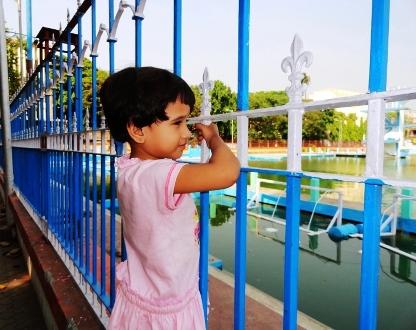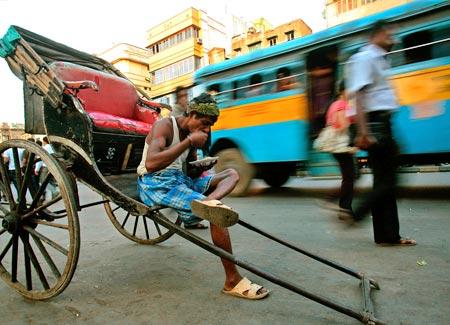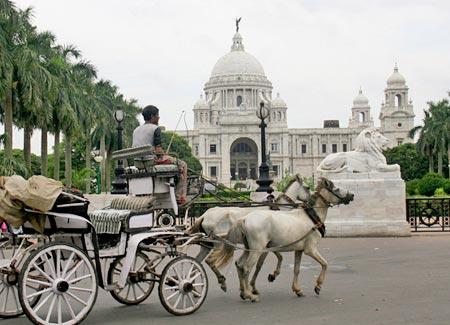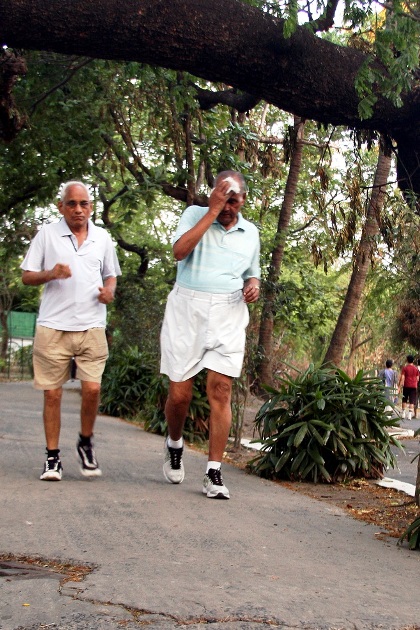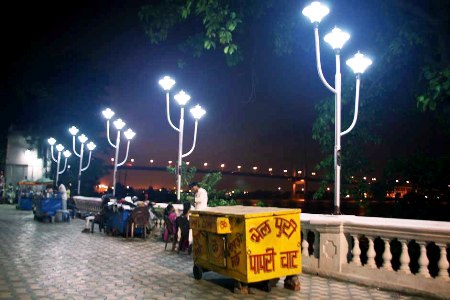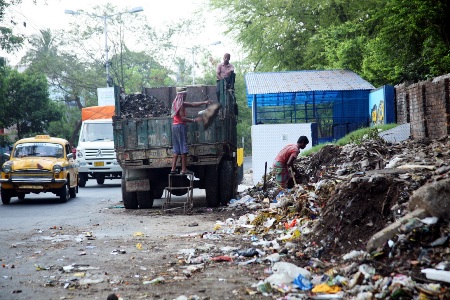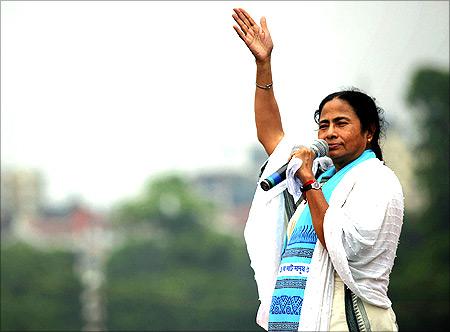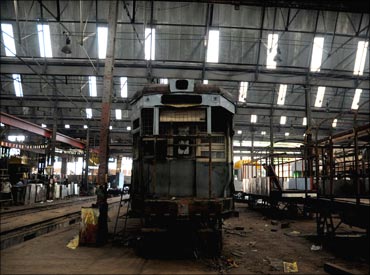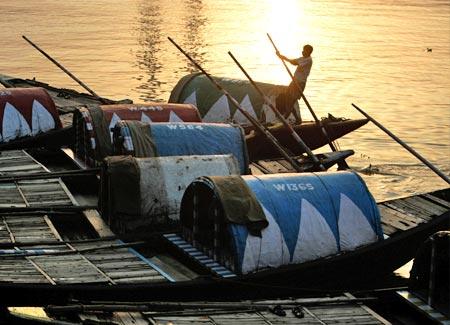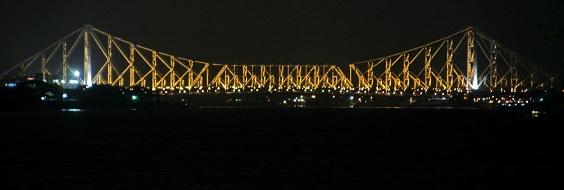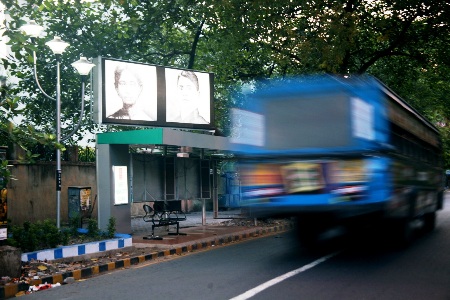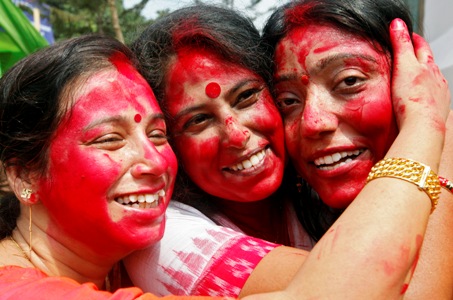 | « Back to article | Print this article |
Can Didi convert Kolkata to London? Bah!
The West Bengal chief minister's dream of transforming her state's capital might prove difficult, writes Parthasarathi Shome.
The chief minister of West Bengal has proclaimed that she will convert Kolkata to London.
The idea did not raise much interest or hope, but deserves consideration.
To begin, she has had Kolkata's public spots, walls, park grilles, and road dividers painted in white and shocking blue -- reminiscent of Mother Teresa -- though, the other evening on television, Mamata explained that the blue was for the open sky, an acceptable enough explanation.
Click NEXT to read further. . .
Can Didi convert Kolkata to London? Bah!
There are also new streetlights and pavement tiles, though neither reveals the robustness that was the hallmark of older versions.
Clearly, however, attempts are on at a certain level, of initiating and implementing decorative change.
Morning constitutionals in Kolkata, for example around Park Circus Maidan, or along stretches in the Ballygunge Lakes between Menoka Cinema and Anderson Club, give a glimpse of the challenges she faces.
Night-time strolls along Southern Avenue and, after crossing the Tollygunge connector, to and beyond Kalighat, or onto Bhawanipur Road past the Greek Orthodox church, are no better.
Click NEXT to read further. . .
Can Didi convert Kolkata to London? Bah!
Alternative walking routes from Gariahat Junction to Park Circus to Park Street Extension, Mullick Bazaar, Linton Street, and into Dr Sundari Mohan Avenue (CIT Road) enhance the scale of complexity.
Such extensive forays, despite demanding the use of all one's reflexes to avoid physical clashes with other pedestrians or animals or being run over by every manner of vehicle, raise the alertness level, enable engagement with one's immediate surroundings that car rides can never make possible, and facilitate contemplation that a drawing-room dialogue in Delhi would never encourage.
A walk around Park Circus Maidan reveals the segments of society that Kolkata embraces -- from the corpulent upper class, of whom there are a handful, to the very bottom of the ladder, destitutes, bathed in dust, who cannot even sit upright from a perennial stupor.
Click NEXT to read further. . .
Can Didi convert Kolkata to London? Bah!
In between are layers of economic and social groups -- energetic young joggers in cheap keds; couples who walk briskly or slowly; gossipers who sit and chat and possibly report taking long walks when back home; a myriad of boys who play cricket and occasionally football, march and drill in uniforms that need ironing, or cluster with their respective girlfriends; and elderly or amputated beggars who have the energy to beg, their money collected intermittently and openly by touts.
A walk into the Maidan in the evening brings to view once again the young population thronging around tree trunks and floating in and out of religious festivities or country fairs.
A morning walk in the Lakes is quite different.
The strollers are mainly upper- or upper-middle class, keeping pace in their Nike or Bata jogging shoes.
Click NEXT to read further. . .
Can Didi convert Kolkata to London? Bah!
The walking path along the long stretch of water is canopied by resplendent Gulmohar and other trees.
The only bother is the possibility of bird droppings -- for that could be the only reason why so many men and women wear caps as they walk in the shade.
The bulging young population is not to be observed here. Just outside of this path, both inside and outside the Lakes, rubbish heaps pile up, and animal and human excreta have to be avoided.
A night walk from Southern Avenue through Kalighat and Bhowanipore begins to reveal the work to be done.
Click NEXT to read further. . .
Can Didi convert Kolkata to London? Bah!
Even Southern Avenue, boastfully declared to be the only remaining boulevard -- garden-like greenery and flower beds in the narrow middle of a wide road -- in Kolkata, has been abused.
Some past local politician is said to be responsible for a grotesque construction in one such middle block that passes as a women's swimming pool, the exterior wall of which serves as a men's room; one block has been converted into a garbage sorter, for which the garbage is first collected there; another block has been partly taken over and built upon by the Kolkata corporation itself, and so on.
Some time ago, a group of enthusiastic school children selected one block to clean up its garbage, and enthusiasts brought sandwiches and cold drinks for them.
Click NEXT to read further. . .
Can Didi convert Kolkata to London? Bah!
The project seems to have trailed off now.
As one approaches Kalighat, sights of the most abject poverty appear, defying description and making one wonder what happens to these families during April nor'westers, now in full sway.
Behind one such family, one climbs a few steps to go into a boutique selling exquisite pieces of art and sculpture from Southeast Asia.
They are a beauty to behold.
It is easy to conclude that, for these poorest of the poor, it hardly matters if they are in the bottom 35, 30, or 25 per cent.
The fact that a 62-year old society is willing to live with such abominable differences in living conditions without being able to pull itself up with its bootstraps, when matched with the perennial excuse that India has democracy, brings forth a measure of disbelief.
Click NEXT to read further. . .
Can Didi convert Kolkata to London? Bah!
Getting on to a tramcar on Gariahat Road, skirting Park Circus into Park Street Extension and getting off at the crossing of Acharya Jagdish Chandra Bose Road and Linton Street exposes the victory of concrete over grass -- for the lawns over which tramcars had plied have been paved over, facilitating the million footfalls and tyres that have to be accommodated along those familiar routes.
Entering Linton Street, which forms a meandering H belt connecting AJC Bose Road and CIT Road, is another eye-opener, with its mounds of garbage spilling over into its distributaries.
The nausea that ensues is hard to control except for the prayer that it must dissipate soon.
A top Delhi technocrat once commented that there must be a public distribution system ration shop every fifty yards in Kolkata.
Click NEXT to read further. . .
Can Didi convert Kolkata to London? Bah!
It remains as a metaphor for the distance between policymakers and the representative Indian.
The shopping centres coming up -- though their existence is not being questioned here -- are for a negligible few.
The vast majority of Calcuttans live a different life.
The communists just had their congress in Kozhikode.
Their statements remained tactical, shying away from matters that might be expected to be central to their concerns.
West Bengal's communists came out as ineffectually as they had in preceding crucial episodes, such as the popular possibility of prime ministership of Jyoti Basu, or the continuance as Lok Sabha speaker of Somnath Chatterjee, succumbing to their Delhi bosses.
Click NEXT to read further. . .
Can Didi convert Kolkata to London? Bah!
Little can be expected from them.
Paradoxically, Mamata Banerjee's stridency in refusing to increase any burden on those with lower ability to pay is beginning to make sense.
The solution is not to increase taxes, or indulge in more wasteful expenditure by expanding the budgets of pompous bureaucrats.
The country should begin to challenge budget incrementalism and to demand more out of less.
Efficiency has to be increased through monitoring and evaluation.
There should be a budget freeze and squeeze across ministries.
The international media -- Financial Times and The Economist from the UK and International Herald Tribune (The New York Times) from the US to name some -- have reached the point of ridicule when reporting on India, because of its corruption and lack of leadership and management.
Drastic change is needed and can come only from within.
Click NEXT to read further. . .
Can Didi convert Kolkata to London? Bah!
Ms Banerjee's dream can come true, but not through traditional means.
She has to use imagination to achieve her goal.
She has to reinvent the use of the latent workforce that is in view everywhere in Kolkata -- armies of young people waiting to be called upon with a promise of recognition and involvement.
Social, rather than merely political, engagement can be used as a contemporary tool in schools and colleges without exception or excuse for children of politicians or the rich. Appropriately-guided social projects should be included in the marking system.
Vitalising our youth is not merely a contemporary idea, however.
Click NEXT to read further. . .
Can Didi convert Kolkata to London? Bah!
Earlier generations, through socially motivated school and college programmes, were infused with a fervour that no amount of traditional accomplishments could diminish.
Tasks included a variety of endeavours -- taking care of the terminally ill in slums and government hospitals; helping people who met with accidents after passing a First Aid course; erecting tents for people in emergencies; learning Hindi through the Hindi Prachar Sabha in non-Hindi speaking regions; as well as hiking long distances, learning the constellations in the night sky to find one's way if lost, the Morse Code, swimming, cooking one's own meal, to name a few.
Ms Banerjee should show concrete steps towards reengagement with societal development.
Click NEXT to read further. . .
Can Didi convert Kolkata to London? Bah!
She should continually express and maintain her interest in cleaning up Kolkata, without allocating excessive additional financial resources.
She should benchmark her outcomes with successes in Bhopal, Chennai, Hyderabad and other Indian cities.
Only after that can she realistically think of London.
Second, she could clean up government hospitals from their prevailing diabolical state. Third, she should focus on the condition of school buildings and infrastructure.
Fourth, she should encourage the painting of the facades of homes in designated areas under specific colour guidelines, as is done in Paris or La Boca in Buenos Aires in Argentina, or Santa Marta In Rio de Janeiro in Brazil or other global cities (why focus only on London?)2.
Click NEXT to read further. . .
Can Didi convert Kolkata to London? Bah!
For this last task, she should empower and demand Kolkata's high society -- whom she seems to be accessing in her other efforts -- to take the lead, rather than directing only its Gulliveresque bureaucracy.
Arousing the spirit of Ram Mohan, Anthony Kabiyal, Michael Madhusudan, Vivekananda, Vidyasagar, Netaji, Rani Rashmoni, Rabindranath, Nivedita, and other forbears from the mothballs in which they have been put to slumber over four decades, she must involve Kolkata's youth with specific tasks and witness how they perform.
Mamata should not stop imagining.
But she must be specific and clear in defining programmes and methods, get society's involvement, and show positive outcomes.
Otherwise she will not succeed.
She is being closely watched, no longer for her spritely ways, but whether they can bring results.
The writer is director and chief executive of ICRIER, New Delhi. These opinions are exclusively his own
